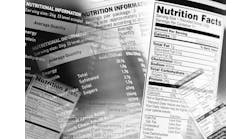After two years of silence, the FDA is indicating it will try to define the term, "natural," for food labeling purposes. FDA commissioner Scott Gottlieb also pledged on March 29 to advance salt reduction goals across the food supply, a move building on the Obama Administration's healthy eating agenda, but going against President Trump's deregulatory push.
"There remains no single more effective public health action related to nutrition than the reduction of sodium in the diet," Gottlieb said during a speech on nutrition agenda at a Consumer Federation of America conference in Washington.
The Obama administration drafted voluntary reduction targets in 2016, but they were delayed by years in part because of intense food industry opposition. At the time, the agency outlined goals to cut back on salt in nearly 150 food categories like frozen pizza, snack foods and canned olives.
Many food manufacturers argue salt is a crucial ingredient not just for flavor, but for food safety and shelf life. The food industry had largely expected the Trump administration would halt the Obama Administration’s moves. But public health advocates have repeatedly urged the FDA to do more to push for large-scale reductions of sodium, saying doing so could save thousands of lives and stave off billions in health care costs. Eating too much sodium is associated with high blood pressure, as well as increased risk of heart attacks and strokes.
Salt makers immediately opposed the FDA's sodium initiative, stating that by moving forward on reductions, saying the agency has "disregarded recent scientific evidence, as well as the direction of Congress and the White House."
A report in Politico indicated the most recent appropriations bill included language that told the FDA to not advance its work on sodium until the National Academy of Medicine had finished reviewing the latest sodium science. That effort will update what’s called Dietary Reference Intakes, known as DRIs, which are a crucial part of the scientific basis for federal nutrition advice and labeling. That review is supposed to happen in January 2019. This signaled the agency would comply with the letter of the spending bill language, but act soon after. The targets are voluntary, but put considerable pressure on food companies to cut back on salt over time.
Gottlieb said he would also direct the agency to continue to discuss longer-term reduction efforts.
Just like other claims made on products regulated by the FDA, Gottlieb said the agency believes the natural claim must be true and based on science. FDA will define “healthy” based on up-to-date nutrition criteria, requiring it to be clearly displayed on food packages. Gottlieb said he even considered putting in place a standard icon or symbol for the word “healthy” featured on food items.
"I feel strongly that the FDA can do more to assist the American public with creating healthier diets for themselves and their families," he added at the consumer group’s gathering as he unveiled the agency’s new nutrition strategy. "We have a real opportunity to reduce the burden of chronic disease through better nutrition. But this is something we can only tackle together, by making better choices easier."
